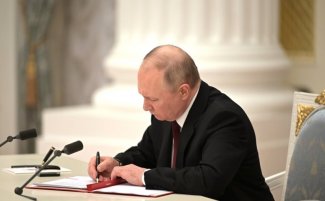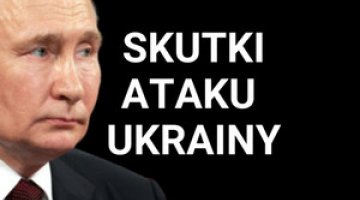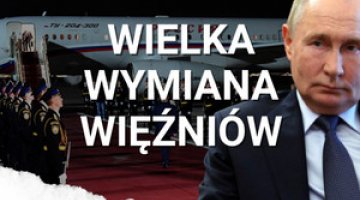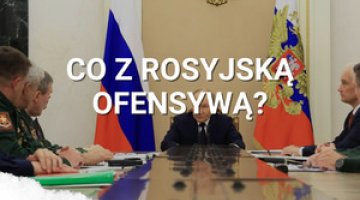Russia recognises the independence of the Donbas

On 21 February, Russian President Vladimir Putin delivered an address in which he announced the recognition of the independence of two separatist para-states created in 2014 in the Russian-occupied part of Ukraine’s Donbas – the so-called Donetsk People’s Republic (DPR) and the Luhansk People’s Republic (LPR). At the same time, he declared the conclusion of a military assistance treaty with them, and demanded that the Ukrainian authorities immediately cease their alleged armed attacks (which are actually fictitious or staged by Moscow) on the DPR and LPR, and threatened an unspecified response from Russia if they did not comply. In his address, Putin repeated a series of propaganda theses, especially concerning the history of the Soviet Union (which was said to be the victim of wrong decisions by its leaders; internal subversion, including by nationalists; and Western conspiracies), Ukraine (which he described as having been artificially created by the Bolsheviks from part of Russia’s historical lands, and now run by an anti-Russian regime subject to Western control, creating a threat to Moscow), and relations with the West (which he portrayed as an adversary seeking to weaken Russia, undermine its development and threaten its security).
Agreements ‘on friendship, cooperation and mutual assistance’ were signed with the para-states. Their signatories were the leaders of the self-proclaimed entities: Denys Pushylin for the DPR and Leonid Pasichnyk for the LPR. The agreements include close political, economic (the Russian rouble will serve as an official currency) and military cooperation with Russia. Their security clauses stipulate the provision of all possible assistance, including military, to repel external aggression, defend the parties' security, sovereignty and territorial integrity, and to maintain peace. They also give the right to use the military infrastructure located on their respective territories. After the conclusion of the agreements, Russia began the process of introducing regular armed forces into the territories of the para-states.
Commentary
- Putin’s decision has made a major change to the political status quo in the Russian-Ukrainian and, more broadly, Russian-Western conflict. It marks another serious breach of international law and an infringement of Ukraine’s territorial integrity by Russia, and at the same time puts an end to the Minsk agreements reached in 2015 in an attempt to regulate the Donbas conflict. Their provisions include the granting of special status (an autonomy of sorts) to the areas occupied by Russia as a result of its aggression against Ukraine (representing about 40% of the area of the Donetsk & Luhansk regions) and their reintegration into Ukraine following local elections on their territories. This was to be linked to a ceasefire in the conflict, the withdrawal of military equipment from the region and the restoration of the Ukrainian authorities’ control over a section of the border with Russia, among other steps. Moscow has tried to force the Ukrainian side to implement these agreements, which are unfavourable to Kyiv, in order to create leverage for political influence on the internal situation in Ukraine and its external policies. Kyiv’s stance – a firm rejection of the Russian scenario – and the ineffective attempts at mediation by Western states have irritated the Kremlin. Its current decision removes the formal political basis for previous attempts to regulate the conflict in Donbas, made within the framework of the so-called Normandy Format (Russia, Ukraine, Germany, France) and the so-called Trilateral Working Group (with the participation of representatives of Kyiv, Moscow and the ‘separatists’, among others).
- The consequences of the decision to recognise the statehood of the DPR and LPR, and the balance of benefits and losses for the parties to the conflict, depend on how the situation further develops, and in particular on Moscow’s policy, which may develop essentially according to one of two basic scenarios:
Escalation scenario
In its framework, Russia’s decision to recognise the DPR & LPR forms the beginning of the next stage of its aggression against Ukraine. In particular, the inclusion of the separatist para-states under Russian security guarantees and the overt introduction of regular armed forces into them (which has already occurred) may create a pretext for launching direct military action against Ukraine (in ‘defence’ against alleged Ukrainian attacks). This could result in a shift of the front line in the Donbas (in the first instance to the administrative borders of the Donetsk and Luhansk regions, whose territory is claimed by the DPR and LPR). As a further escalation, this could also lead to a Russian military attack on Ukraine (air or land) in other regions as well, and in the extreme – albeit least likely– scenario, to a massive invasion of its territory and the occupation of a significant part of it.
Such a scenario could entail taking control of some or all of Ukraine’s territory, but at the same time it would entail very serious costs for the Russian side depending on the level of escalation of its aggression. They would entail both losses among the Russian armed forces and severe consequences – inevitable in such a situation – in the form of serious Western sanctions. It would also lead – against Moscow’s interests – to the political consolidation among the Western states and an increased American presence (including military) on NATO’s eastern flank. The scale of Ukrainian resistance in the areas occupied by Russian troops is also a hugely unpredictable factor.
Pause scenario
Within this framework, the decision to recognise the DPR and LPR by Russia will, at least temporarily, close the current phase of escalating aggression against Ukraine, and will allow the Kremlin to present this decision (especially on the domestic political scene) as a form of punishment for Kyiv and the Western intermediaries, a limited political success (the creation of de facto Russian protectorates on the model of Abkhazia and South Ossetia in Georgia), and an instrument to protect the local population from an alleged Ukrainian attack. This will mean that, for the time being, there will be no further significant escalation of actions against Ukraine, and in particular no massive invasion of its territory. At the same time, recognition of the independence of the DPR and LPR gives Moscow a formal pretext for deepening the area’s de facto integration into the Russian Federation. This may lead the Kremlin to take the next step – the formal annexation of this territory. The threat of such a decision, and of a possible future escalation of the conflict with Ukraine, may become a tool for Moscow to continue to put pressure on Kyiv and the Western countries, and to force them to make concessions.
Such a scenario would mean de facto strategic defeat for Russia in the conflict with Ukraine (as Moscow fails to achieve its main goal, i.e. regaining control over the whole country and influencing its political directions). At the same time, Russia could count on the West continuing the political dialogue on its demands in the sphere of European security. However, such a situation would make it more difficult for Russia to take any possible decisions which would reduce the Western sanctions already introduced against it.
- Neither of the basic scenarios listed above is unequivocally more favourable for Moscow. We may therefore expect that it will try to implement elements of both of them, and to use the DPR & LPR for escalations of limited (variable) intensity and, in effect, a long-term ‘war of attrition’ against Ukraine. Moscow will use the para-states as a tool to force concessions on Kyiv and the West, including perhaps a new ‘Minsk agreement’ of sorts with better terms for Moscow, and to obtain agreements to its other demands in the sphere of European security. Russia’s decisions on further policy will depend on Ukrainian reactions, and above all, on the responses from Western states (especially the US), including those related to sanctions.




